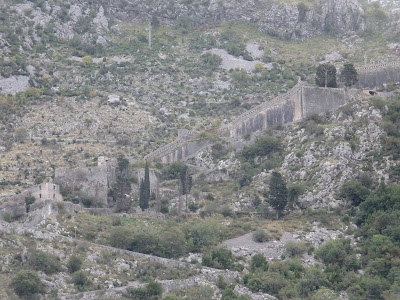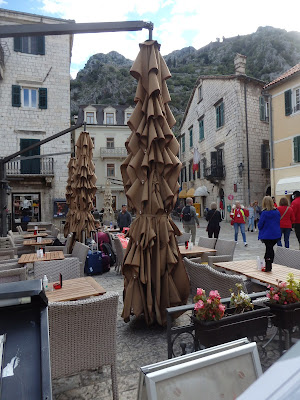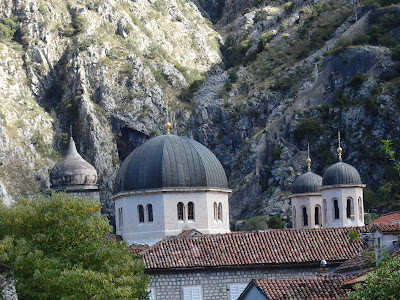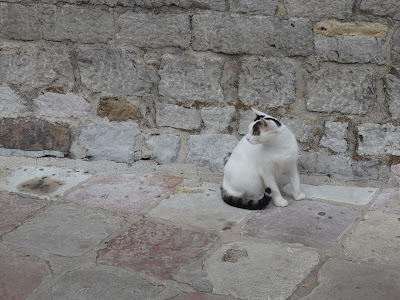 |
Info from the Viking Daily. Double click to enlarge for reading.  |

 |
| Looks like the buses are ready to take cruisers on excursions. My sister and I didn't have to take a bus for our excursion. |
 |
| Fortress walls go from Old Town all the way to the top! This photo shows the bottom part. |
 |
| There is a 1.3 mile trail that also winds up the hill. Once you get to an altitude of 300 feet, you come to the Church of Our Lady of Remedy which dates back to 1518. |
 |
| The walls continued past the church, |
 |
| and serpentine their way up the hill... |
 |
| Some parts of fortress St. John (Sveti Ivan) are built lower on the hill. Construction of the fortress started in the 9th century and ended in the 15th century. |
 |
| Up at the very top, at around 920' in elevation, is Fortress St. John, or San Giovanni as it is locally know. Only 1350 steps from bottom to top. |
 |
| Our ship, the Viking Sea, at Kotor port |
 |
| I had never sees umbrellas like this before and I.... |
 |
| ...couldn't believe how much area they covered once they were deployed. You can see the south side of the clock tower in this photo. |
 |
| Sure wished I could remember what the tour guide said about this giant lamp in Arms Square. |
 |
| Ah yes, the cats. They are everywhere. Cats are featured on many of the t-shirts and souvenirs sold in the town's shops. |
 |
| Our walk continues into Saint Tryphon's Square, the main square of Kotor. |

 |
| The sarcophagus of Andrea Saracenis, who is the assumed founder of the church |
 |
| When I look at this huge cathedral and think about the labor and ingenuity that went into its construction in the 12th century, I'm just amazed. |
 |
| As I said, cats are everywhere but this one isn't real. |
 |
| Our tour included the Maritime Museum. The first room of displays is the Entrance Hall where there are bronze panels in relief of the most significant events and characters that played great role in the history of Bay of Kotor such as this one of the war of Lepanto in 1571, |
 | |||
| Captain Ivo Visin with his brigantine "Splendido", the first South Slav to circumnavigate the world, from 1852 to 1859. |
 |
| Relief map of the Bay of Kotor. Old town Kotor is at the end of the top right "wing". |
 |
| Models of some of the important ships in Kotor's history |
 |
| Around the top of the walls were the emblems of each family. |
 |
| This drawing room is the legacy of the well-known Ivelic family from Risan. |
 |
| Women's national costume from the vicinity of the town of Bar (19th and 20th century). |
 |
| Antique chest of drawers from the Bay of Kotor topped by a French clock from the 19th century. |
 |
| There are 17 panels of old weapons. |
 |
| These rifles were very long and... |
 |
| very decorated. |
 |
| This cat was "guarding" a shop door. |
 |
| Fancy gelato display |
 |
| St Nicholas’ Church (Sveti Nikola) is a Serbian Orthodox church that on St Luke’s Square (Trg Svetog Luka). |
 |
| Saint Luke’s (Sveti Luka) Church for which the square is named, has served both Kotor's Catholic and Orthodox citizens. |
 |
| Sign on the church |
 |
| Very good way to haul stuff in this old town of pedestrian walkways..... |
 |
| and narrow alleys |
 |
| We never got back to check out what was available at the bazaar. |
 |
| This shop specialized in knitted animals. |
 |
| A few shops had these drop lights that were very beautiful |
 |
| Headed toward Kampana Tower and citadel. |
 |
| Kampana Tower and the citadel as seen from the ship. They were built from the 8th to the 19th centuries and controlled access to Kotor from the sea. |
 |
| View of our ship from the top of the walls. |
 |
| Looking back towards town, we could see many church towers. |
 |
| Looking down into the clear water by the wall. |
 |
| Looking back up towards the fortress on the hill. |






















No comments:
Post a Comment